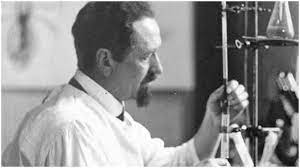Know About Polish Biologist Rudolf Weigl
About Rudolf Weigl
Rudolf Stefan Jan Weigl was a Polish biologist, physician and inventor, known for creating the first effective vaccine against epidemic typhus.
He was born on 2 September 1883 and passed on 11 August 1957.
Rudolf was born in Prerau, then part of the Austro-Hungarian Empire, to Austrian parents.
When he was a child, his father died in a bicycle accident.
His mother, Elisabeth Kroesel, married a Polish secondary-school teacher, Józef Trojnar.
Weigl was raised in Jasło, Poland.
Although he was a native German speaker, when the family moved to Poland, he adopted the Polish language and culture.
He was nominated for the Nobel Prize in Medicine each year between 1930 and 1934, and from 1936 to 1939.
Weigl worked during the Holocaust to save the lives of countless Jews by developing the vaccine for typhus and providing shelter to protect those suffering under the Nazi Germans in occupied Poland.
For his contributions, he was named a Righteous Among the Nations in 2003.
Also Read, Know About Tre Tre Thornton Son Of Young Dolph

| Full Name | Rudolf Stefan Jan Weigl |
| Date Of Birth | 2 September 1883 |
| Date Of Death | 11 August 1957 |
| Age | 73 years |
| Place Of Birth | Prerau, Austria-Hungary |
| Nationality | Polish |
His study on typhus fever
Rudolf Weigl started his study on typhus fever still in time of the first World War, and developed them in 1920 as a member of the Military Sanitary committee.
The study has been carried out for all periods of 20 years between the World Wars.
As the greatest achievement of Weigl in the field of microbiology there should be recognized the use for the first time of a bacterial culture in a living organism, and then production of efficient typhus fever vaccine.
Of great importance there was a production of vaccine for succeeding armies occupying Lvov; Soviet and German.
Weigl’s Institute was a harbor for numerous crowds of educated Poles, who–thanks to being employed at the institute–were protected against repressive measures from German invaders.
Occasionally the institut was supplying the Polish population with vaccines.
Rudolf Weigl’s achievement
The typhus-infecting bacteria, Rickettsia prowazekii, are usually carried by body lice and so this insect was adapted into a laboratory specimen by Weigl.
Rudolf Weigl studied this specimen for years and his research revealed how to use lice to propagate the deadly bacteria with the hope of developing a vaccine. In 1936, Weigl’s vaccine successfully inoculated its first beneficiary.
During the Second World War when Germany occupied Poland, Weigl was forced to open a vaccine production plant.
Rudolf Weigl used the facility to hire friends and colleagues at risk of persecution under the new regime. Due to Weigl’s work during the war period, over 5,000 people were saved.
Rudolf Weigl helped people both directly and indirectly. His efforts protected his neighbors and thousands of vaccine doses were distributed nationwide.
Today, Rudolf Weigl is widely known as a remarkable scientist and hero. His work has been honored by two Nobel Prize nominations.

Typhus infection
Louse-borne Typhus Fever is one of the oldest pestilential diseases of humankind.
It was first recognized in the late fifteenth century with certainty as causing devastating epidemics.
Some of the symptoms of the disease include chills, fever, and severe headaches. The duration of the fever is from 10 to 21 days.
But, in severe cases, this develops into stupor and coma, accompanied by secondary infections and renal failure.
And today, with the help of antibiotics including tetracyclines, quinolones, chloramphenicol, and para-aminobenzoic acid, the risk of a fatal issue is greatly reduced.
Also Read, Bodhi Soleil Reed Somerhalder, Daughter Of Nikki and Ian Somerhalder
Vaccine development
In 1930, following Charles Nicolle’s 1909 discovery that lice were the vector of epidemic typhus, and following the work done on a vaccine for the closely related Rocky Mountain spotted fever, Rudolf Weigl took the next step and developed a technique to produce a typhus vaccine by growing infected lice and crushing them into a vaccine paste.
Rudolf Weigl discovered that a vaccine could be developed from lice stomachs infected with Rickettsia prowazeki, the causative agent of typhus in humans.
Rudolf Weigl developed this first version of the vaccine in 1918 and began experimenting on guinea pigs and even human volunteers.
He refined this technique over the years until 1933 when he performed large-scale testing to cultivate bacteria and experiment with the lice using a micro-infection strategy.
The method comprised four major steps:
- Growing healthy lice, for about 12 days;
- Injecting them with typhus;
- Growing them more, for 5 additional days;
- Extracting the lice’s midguts and grinding them into a paste (which was the vaccine).
Growing lice meant feeding them blood, the more human the better.
At first he tested his method on guinea pigs, but around 1933 he began large-scale testing on humans, feeding the lice human blood by letting them suck human legs through a screen.
This could cause typhus during the latter phase, when the lice were infected.
He alleviated this problem by vaccinating the human “injectees”, which successfully protected them from death (though some did develop the disease).
Weigl and his wife Zofia Weigl were some of the earliest lice feeders. He developed the disease, but recovered.
The first major application of his vaccine was conducted between 1936 and 1943 by Belgian missionaries in China. Soon, the vaccines were also administered in Africa.
The vaccine was dangerous to produce and hard to make on a large scale.
Over time, other vaccines were developed that were less dangerous and more economical to produce, including the Cox vaccine developed on egg yolk.
Awards and honors
Weigl was continuously nominated for a Nobel Prize in the years 1930–1934 and 1936–1939.
Despite these nominations, he never received a Nobel Prize for his vaccine accomplishments or social work.
A half-century after his death, Weigl’s research, work, and service were recognized by many. In 2003, he was honored as Righteous Among the Nations.
This award was given by Israel and commemorated his work for saving countless Jewish lives during World War II.
On 2 September 2021, Google commemorated Weigl’s 138th birthday with a Google Doodle.
Also Read, All About Dallas Yocum Ex-Wife Of Mike Lindell
Follow us or bookmark us for more Celeb Bio box office collection report celebrities trailers and promos
Join us on Facebook
Join us on Twitter


